Physical addiction: signs, types, and treatments
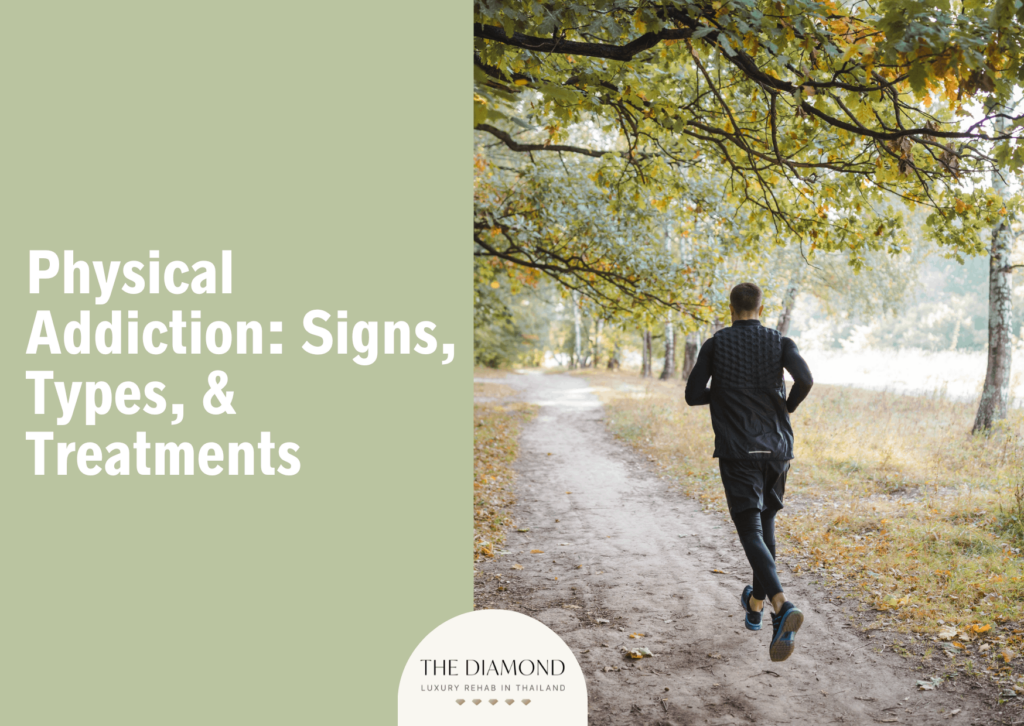
Physical addiction is a type of addiction that causes physical symptoms and consequences. It is a compulsive urge to keep using addictive substances even when they keep causing problems or jeopardizing health.
Signs of physical addiction are enlarged or constricted pupils, sudden changes in weight, insomnia, bloodshot eyes, unusual body odors, poor coordination, looking unkempt, and slurred speech.
Types of physical addiction are numerous and usually refer to the actual addictive substance used. Common types are addiction to alcohol, tobacco, opioids, prescription drugs, cocaine, marijuana, amphetamine, hallucinogens, inhalants, and PCP.
Treatments for physical addiction include detoxification, counseling and therapy, rehabilitation, medications, and self-help groups.
What is physical addiction?
Physical addiction is a compulsive urge to use addictive substances despite physical complications and symptoms they cause. Addictive substances act on chemical levels in the brain. More precisely, they affect neurotransmitters such as dopamine, which is in charge of the brain’s reward system and regulates emotions.
When levels of those neurotransmitters change, even in the short term, they induce a powerful effect. They produce new normal in a person’s brain. With prolonged use, the body and brain get used to a specific dosage or amount of that substance. They feel no use for it anymore and call for higher amounts. That is called tolerance, which leads to physical dependence and addiction.
So, when a person stops using the addictive substance, the body craves it. At the same time, the body responds to the lack of the addictive substance through a wide range of physical symptoms.According to results from the 2019 National Survey on Drug Use and Health published in 2020 by the Substance Abuse and Mental Health Services Administration (SAMHSA), substance use disorder (SUD) affected over 20.4 million individuals 12 years of age and older in the previous year.
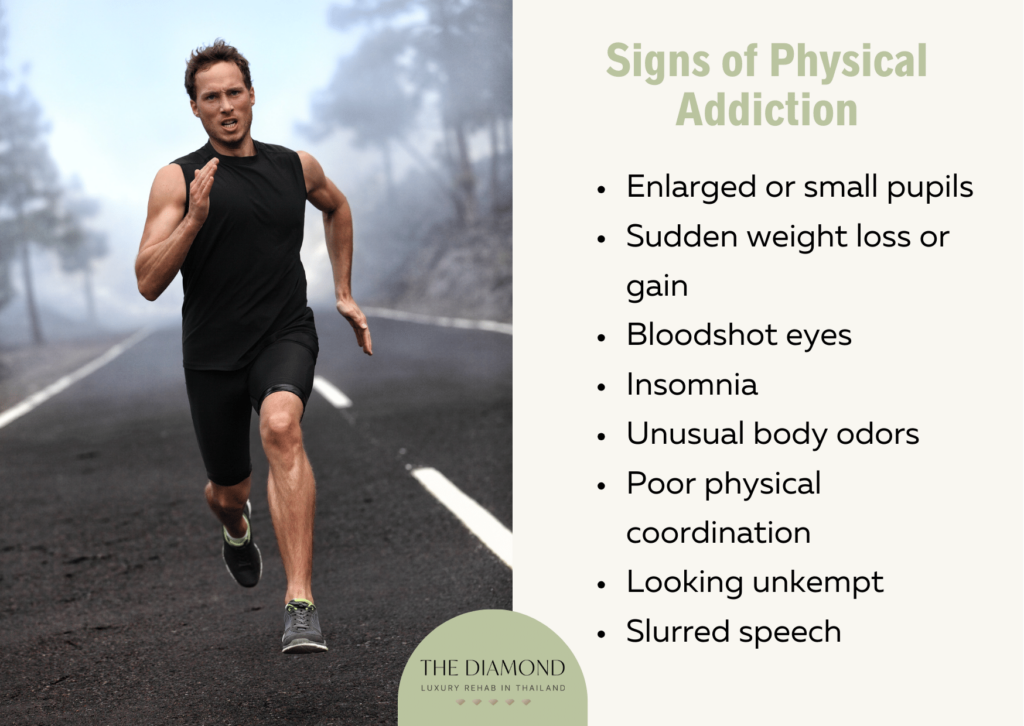
What are the signs of physical addiction?
Signs of physical addiction vary from mild to serious in terms of intensity, depending on the severity of addiction and type of substance abuse. The most common signs of physical addiction are listed below.
- Enlarged or small pupils
- Sudden weight loss or gain
- Bloodshot eyes
- Insomnia
- Unusual body odors
- Poor physical coordination
- Looking unkempt
- Slurred speech
1. Enlarged or small pupils
Enlarged or small pupils are linked to the impact of addictive substances on the nervous system and the neurotransmitters involved in addiction. When someone is physically dependent on a substance, their body undergoes various physiological changes, and alterations in pupil size are one of the observable signs.
Addictive substances have a direct impact on the pupils of the eyes. Substance misuse negatively affects the eyes’ response to nervous stimulation. As a result, physical addiction causes enlarged or small pupils.
That happens because sympathetic and parasympathetic nervous systems regulate the dilation and constriction of the pupil. Failing to constrict or dilate properly indicates potential nerve damage and leads to the onset of vision problems, which are long-term effects of this symptom. Short-term effects are sleepiness, confusion, nausea, and vomiting.
Drugs and opioids cause constricted pupils, i.e. the condition known as pinpoint pupils. On the flip side, stimulants cause enlarged pupils or mydriasis. Short-term effects of enlarged pupils are blurry vision, eye irritation, headaches, and a general feeling of constriction around the forehead and the eyes. Long-term effects of enlarged pupils are vision issues such as age-related macular degeneration and vision loss.
The best way to determine whether pupils are constricted is to observe them in bright light. They tend to remain small. Enlarged or dilated pupils (black circles in the eyes) don’t respond to light changes at all.
2. Sudden weight loss or gain
Sudden weight loss or gain describes significant changes in an individual’s body weight due to the profound impact of addictive substances on their overall health and lifestyle. The reasons behind these changes vary depending on the type of substance being abused. For instance, stimulant drugs suppress appetite, leading to weight loss, while certain other substances contribute to increased food intake and subsequent weight gain.
The effects of addictive substances on weight tend to be direct and indirect. Various people with drug addiction appear malnourished and underweight.
Certain addictive substances accelerate metabolism, increase energy levels, and reduce appetite. A combination of these factors leads to weight loss because a person loses more calories than they consume during the day.
At the same time, certain drugs stimulate the appetite and reduce energy levels. That way, a person consumes more calories than they burn during the day. As a result, they gain weight.
Short-term effects of sudden weight loss are reduced energy levels, irritability, headaches, and constipation. Long-term effects of sudden weight loss range from loss of bone, muscle mass, and weakened immune system due to malnourishment. People additionally develop various health problems due to a lack of much-needed nutrients.
Short-term effects of sudden weight gain include swollen ankles and feet, heavy breathing, and confusion. Long-term effects of weight gain include memory loss, high blood pressure, and an increased risk of cardiovascular diseases and mental health problems.
Recognizing this symptom is easy because an addicted person and their friends or family see changes in their appearance.
3. Bloodshot eyes
Bloodshot eyes occur because blood vessels on the surface of the eye dilate or widen in response to the use of certain addictive substances. Physical dependence drugs that are known for causing this symptom include cocaine, alcohol, and marijuana.
Short-term effects of bloodshot eyes are usually mild discomfort and itching. At times, a person doesn’t experience any addiction symptoms or effects. However, in certain cases, pain, eye discharge, and blurred vision occur. These effects usually symbolize the presence of a more serious problem, such as glaucoma.
In order to determine whether this symptom is present, it’s necessary to stand in front of a mirror and inspect the eyes. If the white area of the eye is tinted with a red hue or appears bright red, it means a person has bloodshot eyes.
4. Insomnia
Insomnia, characterized by persistent difficulty falling asleep or staying asleep, is often associated with the use of certain substances. The impact on the central nervous system and neurotransmitter functions induced by addictive substances interfere with the natural sleep-wake cycle.
Physical addiction causes insomnia because addictive substances acutely disrupt sleep regulatory systems in the brain. As a result, they affect sleep latency (the time it takes to fall asleep), sleep quality, and duration of sleep.
According to a 2020 article written by Dr. Nora Volkow for the National Institute on Drug Abuse, drug users who are going through withdrawal often have insomnia, which increases their need for drugs and can play a significant role in their relapse. Yet another explanation for why drugs cause insomnia is that they act on dopamine, which is implicated in the sleep-wake cycle.
Short-term effects of insomnia include increased stress, emotional distress, reduced quality of life, performance deficits, and behavior problems. Long-term effects of insomnia are hypertension, heart attack and stroke, diabetes, weight gain and obesity, memory problems, and weakened immune system.
In order to determine whether insomnia is present, a person needs to evaluate their quality of sleep. Generally speaking, insomnia refers to trouble falling or staying asleep at least three nights a week for three months or longer.
5. Unusual body odors
Unusual body odors describe the distinct and atypical smells emanating from an individual, which are linked to the metabolic byproducts of substance abuse. These olfactory changes result from the body’s attempt to metabolize and eliminate the ingested substances.
Certain drugs are made from several chemicals that tend to have a bad odor. A good example is methamphetamine. Long-term use of these substances change how a person’s sweat or breath smells. People with physical addiction and those who are going through withdrawal experience profuse sweating. Profuse sweating produces a more potent odor. Additionally, persons with physical addiction often neglect hygiene, which contributes to unusual body odors.
Unlike other symptoms of physical addiction, this one doesn’t have specific short- and long-term effects. However, people feel uncomfortable being around a person with bad body odor. It potentially leads to irritations and infection because odor comes from bacteria.Everyone easily determines this symptom because it’s not difficult to realize that someone’s got bad breath or that their body has a bad odor.
6. Poor physical coordination
Poor physical coordination refers to impairment of motor skills indicated by an uncoordinated movement that might affect speech, walking, eye movements, ability to swallow, and other functions. Physical addiction causes poor physical coordination because it impairs motor functions and disrupts a person’s daily life. Chemicals from addictive substances can impair communication between the brain and other parts of the body.
Short-term effects of poor physical coordination include difficulty performing some everyday tasks such as buttoning the shirt, throwing a ball, writing, and walking. Long-term effects of this symptom of physical addiction include an increased risk of injuries and other problems that put a person’s life in danger.
Common drugs that cause poor physical coordination include cocaine, alcohol, heroin, and others.
The best way to recognize this symptom is through loss of balance, taking wide steps when walking, shaking hands, dizziness, and hearing problems.
7. Looking unkempt
Looking unkempt means that individuals struggling with addiction neglect personal hygiene and grooming practices due to the disruptive nature of their substance use. This neglect manifests in disheveled appearance, uncombed hair, and wrinkled or dirty clothing. The decline in self-care reflects the all-consuming nature of addiction, which trumps personal maintenance and daily activities.
A person stops brushing their teeth, washing their face, taking showers, brushing or combing hair, and shaving. Looking unkempt is a major symptom of physical addiction.
Short-term effects of this symptom of physical addiction include bad breath, bad body odor, discomfort among other people, and others easily noticing that something is not right. Long-term effects of this symptom include an increased risk of tooth decay and tooth loss, dermatitis, and various infections.The easiest way to determine whether an individual has this symptom is to take a closer look at their appearance and see whether they regularly work on it. Those who look unkempt usually appear as persons who are in need of showering or tooth brushing.
8. Slurred speech
Slurred speech involves difficulty in controlling the muscles involved in speech, leading to a slowed and indistinct manner of speaking. It is a visible and audible manifestation of the immediate physiological effects of substance abuse, providing observers with a clear indication of potential addiction issues.
Certain addictive substances slow down communication in the brain. Slow or delayed communication leads to impaired functions that rely on it. One of these functions is speech. Physical addiction manifests itself through slurred speech, whose short-term effects include very loud or quiet speech, hoarse voice, and difficulties speaking in a regular rhythm.
Long-term effects include the inability to express oneself to others and thereby causing more problems. Plus, long-term slurred speech indicates the presence of a more serious problem. To recognize slurred speech, it’s useful to look out for monotone speech, uneven speech volume, and speech that is difficult to understand.
How to prevent physical addiction?
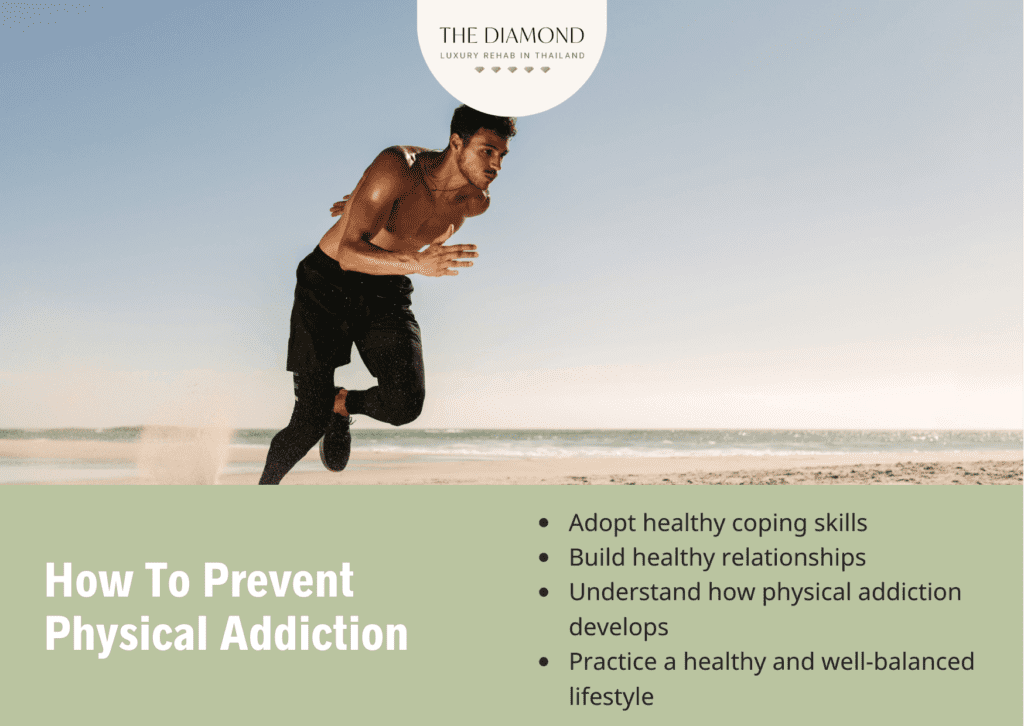
Preventing physical addiction entails taking proactive steps to reduce the likelihood of substance abuse. The ways on how to prevent physical addiction are listed below.
- Understand how physical addiction develops
- Acknowledge that recreational use of certain drugs lead to physical addiction
- Avoid temptation and stay away from people who use addictive substances
- Teenagers should avoid their peers who put pressure on them to try drugs
- Seek help for the management or treatment of mental health illnesses
- Eliminate modifiable risk factors i.e. factors that we’re able to change
- Practice stress management and overcome life stressors
- Build healthy relationships
- Adopt healthy coping skills
- Practice a healthy and well-balanced lifestyle.
What are the risk factors for physical addiction?
Risk factors for physical addiction include genetics, medical history, environment, type of addictive substance, age, and method of use.
Physical addiction isn’t a matter of lack of discipline or morals, heredity (genetics) plays a major role here. According to a 2023 research topic titled, “Prevention” from the National Institute on Drug Abuse, genetics account for up to half of an individual’s chance of developing an addiction to alcohol, nicotine, or other drugs.
For example, a study by Demontis et al., published in the July 2019 issue of Nature Neuroscience found that cannabis use disorder is heavily influenced by genetic factors, with CHRNA2 being identified as a potential contributing factor. Low expression of this gene is associated with marijuana addiction. That means a person’s risk of developing physical addiction is a lot higher if their family members have it as well.
When it comes to medical history, a person is more susceptible to developing physical addiction if they have an underlying mental health condition such as depression. Not only do these conditions increase addiction risk, but addiction worsens their symptoms at the same time. Other medical causes of addiction include illnesses and injuries that change a person’s lifestyle and encourage them to use drugs to cope.
Environmental risk factors of physical addiction usually include lack of parental involvement in childhood and adolescence, peer pressure, and the availability of addictive substances in a person’s social group.
A person’s age plays a big role in the likelihood of physical addiction. In this case, the accent is mainly on the age of first use of an addictive substance. Early exposure to the substance, e.g. in adolescence, significantly increases the risk of addiction in adulthood.
Certain drugs induce physical addiction faster than others. For that reason, the choice of an addictive substance increases the risk of developing an addiction. Drugs such as cocaine, methamphetamine, and heroin are more physically addictive than cannabis and alcohol. This doesn’t mean alcohol and marijuana are safer for use but only implies that a person becomes addicted to cocaine and other drugs a lot faster.
Method of use as a risk factor for physical addiction refers to the way a person takes the addictive substance. Substances that are injected or smoked are more addictive than drugs that are swallowed.
The reason is simple; compounds from drugs that are smoked or injected go straight into the bloodstream and reach the brain within seconds. On the flip side, drugs that are swallowed need to be broken down first, which takes longer.
What are the types of physical addictions?
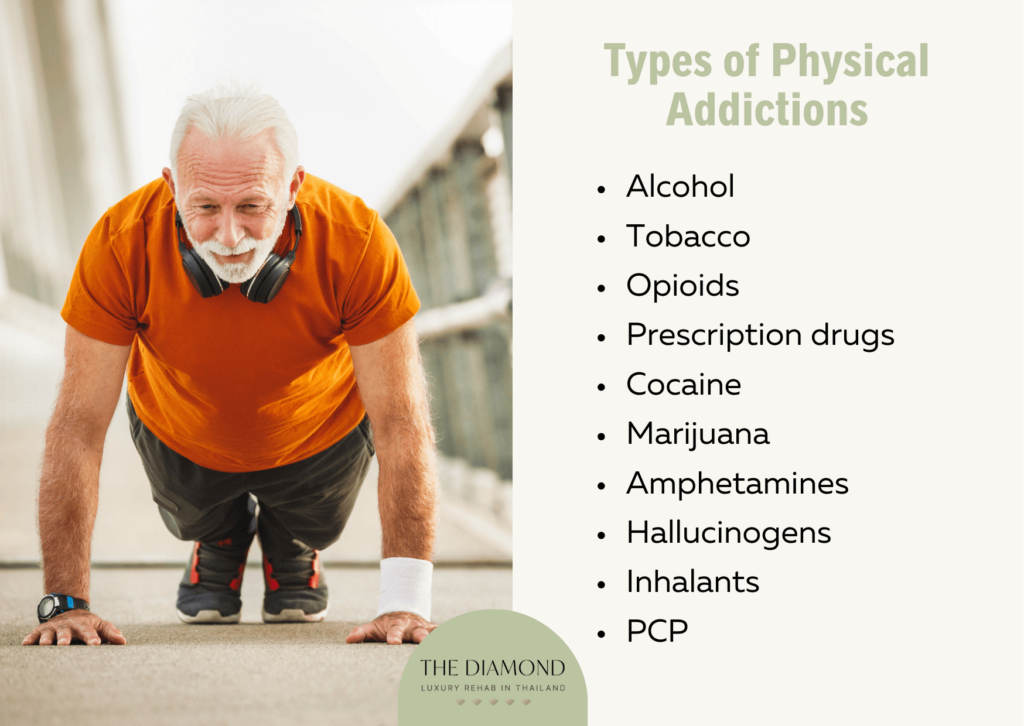
Types of physical addictions are listed below.
- Alcohol
- Tobacco
- Opioids
- Prescription drugs
- Cocaine
- Marijuana
- Amphetamines
- Hallucinogens
- Inhalants
- PCP
1. Alcohol
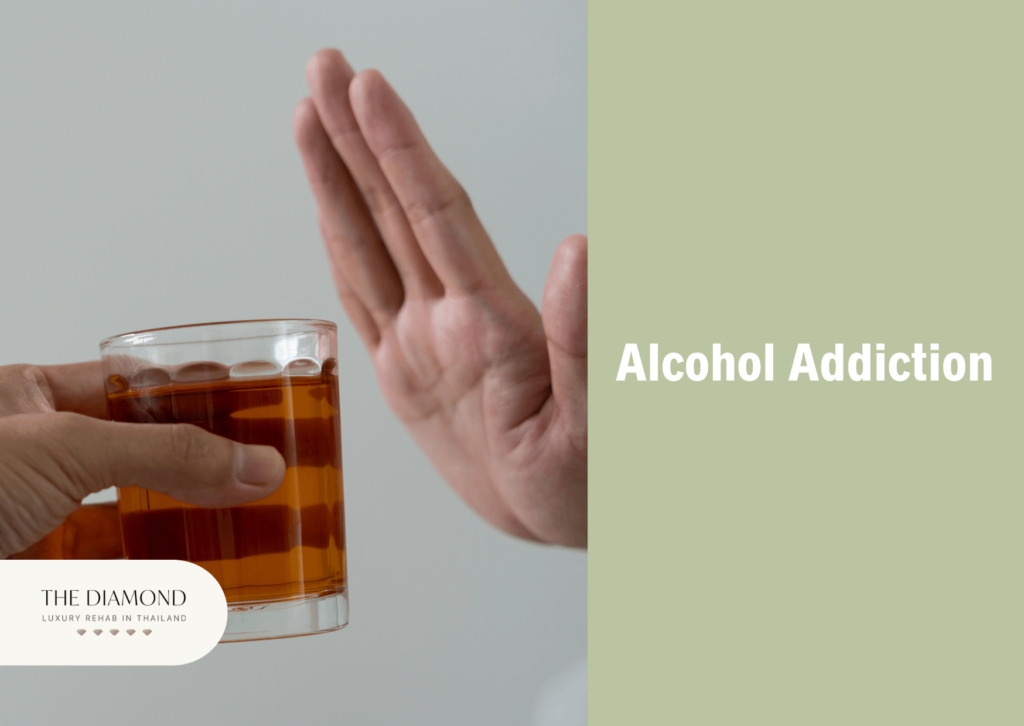
Alcohol addiction, known as alcoholism and alcohol use disorder, is a chronic relapsing disorder wherein a person compulsively drinks alcohol, regardless of the consequences it causes. Having a drink or two isn’t alcohol addiction. Heavy, frequent alcohol intake is a sign of a problem.
Common symptoms of alcohol addiction include increased quantity or frequency of use, high tolerance for alcohol, drinking at inappropriate times, socializing with people who drink heavily, and avoiding friends and family.
Other symptoms of alcohol use disorder include hiding alcohol and lying about the extent of the problem, relying on alcohol to function during the day, increased depression and other emotional issues, and experiencing financial, legal, or professional problems due to alcohol use.
The exact cause of alcohol addiction is unclear. According to a 2022 article titled, “Alcohol use disorder” from Mayo Clinic, a combination of environmental, psychological, genetic, and social causes is the main culprit. Drinking too much alcohol affects the function of areas of the brain that regulate the experience of pleasure, ability to control behavior, and judgment. As a result, a person experiences strong cravings for alcohol.
Common risk factors for alcohol addiction include early exposure to alcohol, family history, depression or other mental health illnesses, history of trauma, bariatric surgery, and social and cultural factors.
Short-term effects of alcohol addiction are poor vision, slurred speech, fluctuating emotions, passing out, vomiting, alcohol poisoning, and alcohol-induced psychosis. Long-term effects of alcohol addiction include liver damage, depression, permanent brain damage, nerve damage, high blood pressure, cancer, and immune system problems.
Treatment of addiction on alcohol depends on the specific needs of each patient. It is likely to include a brief intervention, an outpatient program, individual or group counseling, or an inpatient program. The first step of the treatment is detox, which takes two to seven days. During this period, a patient experiences various withdrawal symptoms.
The most common symptoms of withdrawal include strong cravings for alcohol, anxiety, tremors, nausea and vomiting, headache, sweating, irritability, increased heart rate, confusion, and insomnia.
In order to overcome alcohol use disorder, a patient needs a strong support system. A treatment program is necessary as well, but the type depends on the severity of the addiction. For example, mild to moderate addiction requires an outpatient treatment program, whereas severe addiction calls for an inpatient or residential treatment program.
A person with alcoholism needs to avoid socializing with other people who consume a heavy amount of alcohol. In certain cases, a healthcare provider prescribes medications to reduce cravings and lessen the severity of withdrawal syndrome. Patients additionally receive a prescription for underlying health problems such as depression.
It is particularly necessary to be proactive about alcohol addiction treatment because it has a severe psychological impact. Not only do mental health problems increase the risk of alcoholism, but alcohol addiction worsens these conditions and severely harms mental health. Men and women with alcohol use disorder exhibit symptoms of depression, anxiety, and agitation.
2. Tobacco
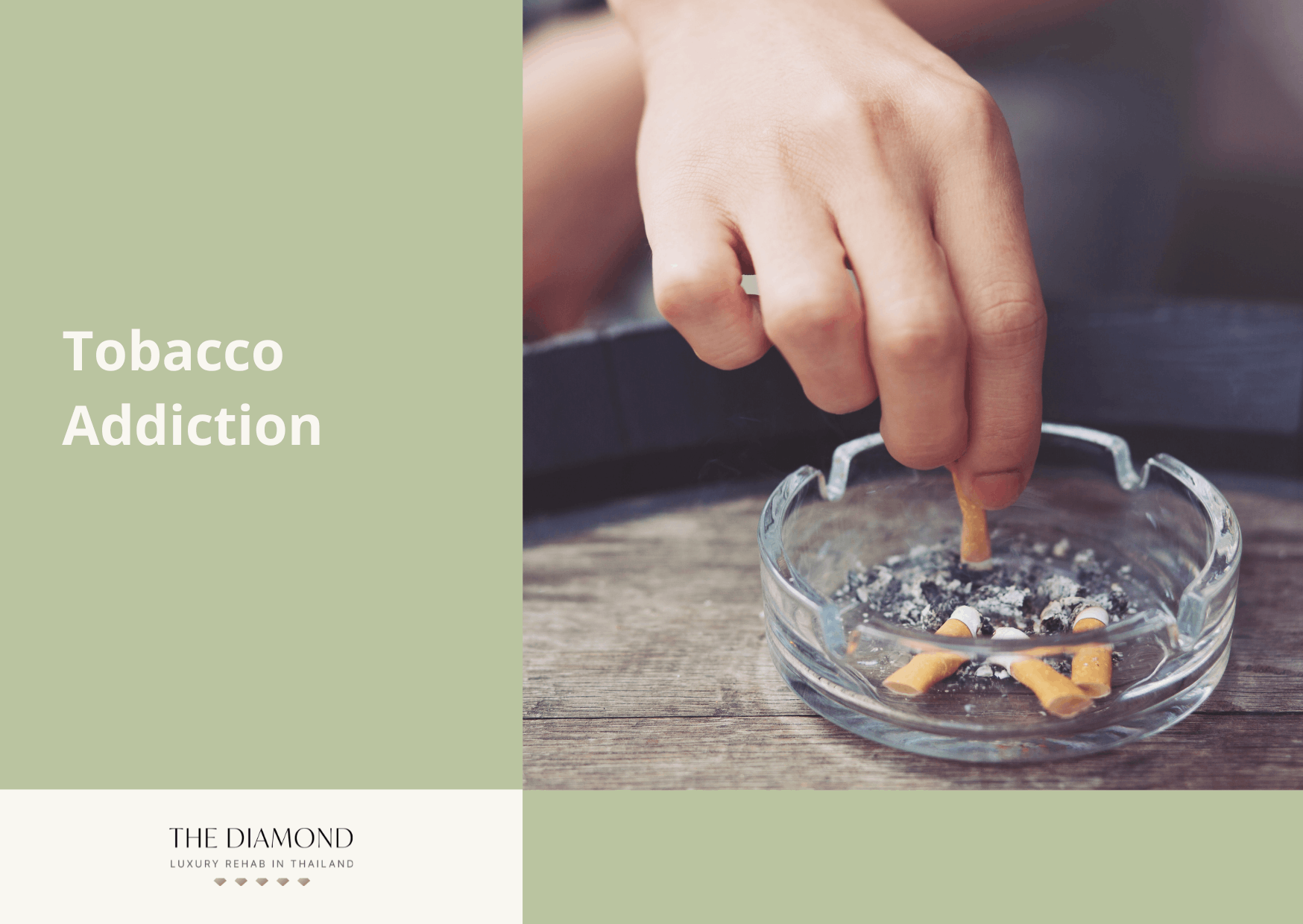
Tobacco addiction is a type of physical addiction wherein a person is dependent on the effects of nicotine, the main active compound in tobacco. Nicotine is addictive because it boosts mood quickly. As a result, a person wants to use it more, which is why they develop tolerance. That means they need to keep using tobacco products in order to experience the same desired effects.
Symptoms of tobacco addiction include the inability to stop smoking despite efforts to do so, experiencing withdrawal symptoms when not smoking, and giving up social activities if they imply smoking is forbidden.
The main cause of tobacco addiction is the effect of nicotine on dopamine levels in the brain. Within a few seconds after taking a puff of a cigarette, nicotine reaches the brain. There, nicotine elevates the release of neurotransmitters, which control behavior and mood. One of these neurotransmitters is dopamine. The more a person smokes, the more they need to induce the same effects of dopamine. This leads to tolerance, dependence, and then tobacco addiction.
Factors that increase the risk of addiction to tobacco include early first-time use, genetics, peer pressure, substance abuse, and mental health problems.
Short-term effects of tobacco addiction include a faster heart rate, an increase in blood pressure and respiration, and a calmer mood. Long-term effects of tobacco addiction include increased risk of lung cancer and other forms of cancer, cardiovascular diseases, eye problems, diabetes, faster aging, impotence and infertility, pregnancy complications, tooth and gum disease, and higher susceptibility to cold, flu, and other viruses.
Treatment for tobacco use disorder includes medications and counseling. Medications are known as nicotine replacement therapy, which is either prescription-based or over-the-counter. Their purpose is to reduce withdrawal symptoms and cravings. On the flip side, counseling helps a patient develop the skills necessary to achieve and maintain their recovery.
Speaking of withdrawal, the most common symptoms are cravings for tobacco, anger, frustration, difficulty concentrating, restlessness, insomnia, anxiety, and increased appetite. These symptoms usually begin within a few hours after the last cigarette and last for two to four weeks. However, the first week is the most intense.
In order to overcome nicotine addiction, it’s useful to identify and avoid triggers that increase tobacco use, try relaxation techniques, increase physical activity levels, and remind yourself of the benefits of quitting.
The psychological impact of nicotine addiction includes hostility, anxiety, depression, and false beliefs or justifications.
3. Opioids
Opioid addiction is defined as a compulsive urge to use opioids even when they are no longer medically required or despite the harmful effects they cause. Doctors usually prescribe opioids to treat severe pain. Certain people develop opioid addiction even when they adhere to the instructions provided by the doctor or take the drugs as directed.
Symptoms of opioid addiction include going to extreme lengths to obtain prescriptions, forging a signature, or taking medications prescribed for someone else. Other symptoms of this type of physical addiction include lack of motivation, hyperactivity, depression, weight loss, cramps, gastrointestinal distress, headaches, poor concentration, confusion, mood swings, social withdrawal, poor coordination, and loss of interest in activities once enjoyed.
The causes of opioids addiction are complicated, mainly because they have genetic, environmental, and lifestyle aspects. In most cases, a combination of different factors leads to opioid addiction.
Risk factors for opioid addiction include a history of or present substance abuse problem, untreated mental health issues, younger age, and families or communities that promote or tolerate abuse, according to a 2017 study by Lynn R. Webster published in Anesthesia and Analgesia.
Short-term effects of opioid addiction range from drowsiness, nausea, and constipation to slowed breathing and confusion.
The long-term effects of this type of physical addiction are numerous. They include dehydration, liver disease, pneumonia, cardiovascular diseases, events such as stroke and heart attack, irritability, and suicidal thoughts and behaviors.
People with opioid addiction additionally develop social problems, work or school-related problems, and financial difficulties.
Treatment of opioid addiction includes a combination of medications and therapy. Certain medications, such as methadone and buprenorphine, alleviate cravings without producing the “high” effect. Other patients receive naltrexone, which blocks the euphoric or sedative effects of opioids.
When it comes to therapy, it helps patients develop healthy coping mechanisms so they’re able to stop taking opioids and remain sober.
Proper treatment takes care of withdrawal syndrome, which occurs after stopping opioid use. Common symptoms of opioid use withdrawal include cravings, irritability, sweating, muscle aches, cramps, anxiety, shakes, and suicidal thoughts.Since opioids affect brain chemistry, they contribute to the development of or worsening the symptoms of mental health problems. Their true psychological impact is best described by the fact that several patients with opioid addiction experience suicidal thoughts or tendencies.
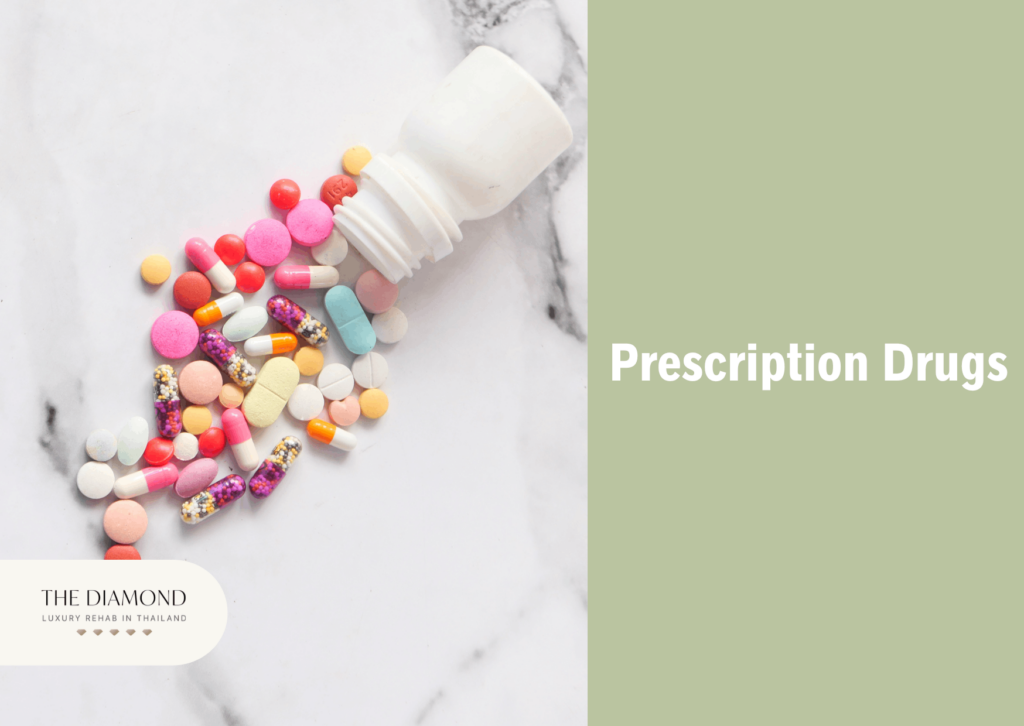
4. Prescription drugs
Prescription drug addiction is the compulsive need to take prescription medications in a way that isn’t their purpose, despite the complications they cause. This type of physical addiction refers to opioids, anti-anxiety medications and sedatives, and stimulants.
Symptoms of prescription drug addiction manifest in psychological, behavioral, social, and physical ways and usually depend on the type of medication abuse. They include depression, anxiety, irritability, mood swings, feelings of euphoria, confusion, memory problems, and visiting multiple doctors to obtain as many prescriptions as possible.
People order prescription medications over the internet and dedicate a lot of time to using these drugs or obtaining them. Other symptoms of prescription drug addiction include nausea, headache, cravings, high body temperature, heart palpitations, disrupted sleep patterns, and slurred speech.
Like other types of addiction, this form of substance use disorder is caused by a combination of genetic, lifestyle, and environmental factors.
Risk factors for prescription drug addiction are similar to those of opioid addiction. These include family history, substance use problems, pre-existing psychiatric conditions, peer pressure, easy access to drugs, and lack of knowledge about their potential harm.
Short-term effects of prescription drug addiction depend on the actual medications. These effects include indifference to physical or emotional pain, drowsiness, relaxation, slow breathing, and constipation.
Long-term effects of prescription drug addiction include coma, overdose, memory problems, heart problems, aggressiveness, hallucinations, and paranoia.
Treatment for prescription drug addiction varies depending on the type of medicine used. The most common treatment approach is psychotherapy. The main goal of therapy is to help patients determine factors that lead to or aggravate prescription drug abuse and learn skills to resist cravings.
Patients additionally need detox or withdrawal and medications. Withdrawal from prescription drug addiction takes a week or two. Symptoms include cravings, restlessness, agitation, nausea and/or vomiting, muscle and joint pain, anxiety, and increased heart rate.
In order to overcome prescription drug addiction, patients need support from friends and family, a well-structured treatment, and strong willpower to commit to the treatment process. The psychological impact of prescription drug addiction is severe in the way a person believes they need the drug to function in their everyday life. Plus, this type of addiction causes depression and other mental health problems in people who don’t have them.
5. Cocaine
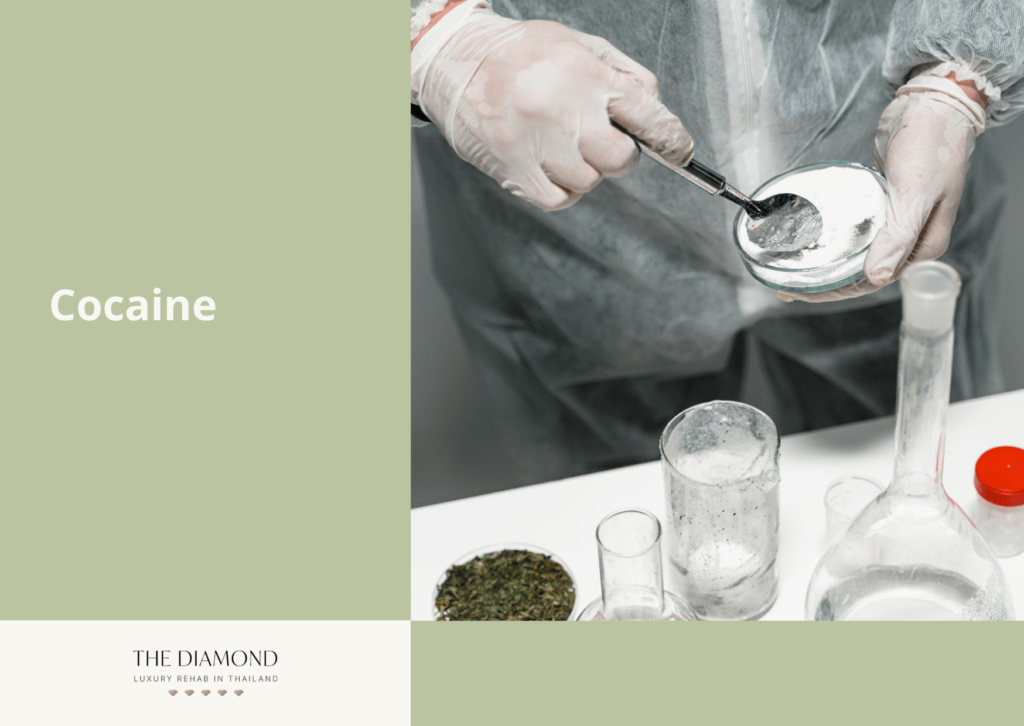
Cocaine addiction is a type of physical addiction that causes withdrawal symptoms when a person stops taking this powerful drug. Like other forms of addiction, cocaine use disorder is indicated by a compulsive need to take the drug even when it harms a person and their quality of life.
Symptoms of cocaine addiction include dilated pupils, high blood pressure and rapid heart rate, erratic behavior, loss of appetite, using increasing amounts of cocaine to experience the same effects, and neglecting responsibilities in favor of cocaine abuse.
Other symptoms of addiction to cocaine include withdrawal syndrome when not using the drug and engaging in risky behaviors just to obtain the drug or under the influence of it. Moreover, symptoms of cocaine addiction include sleep pattern changes, secrecy, and financial problems.
Causes of cocaine addiction include mental illness, genetics, and social pressure. Risk factors linked with cocaine use disorder include early aggressive behavior, loneliness, high stress, being male, poverty, availability of the drug, and lack of parental supervision.
Short-term effects of cocaine addiction include constricted blood vessels, dilated pupils, rapid heart rate, increased body temperature, and higher blood pressure. Long-term effects of cocaine addiction range from loss of smell, trouble swallowing, asthma, respiratory infections, and a higher risk of pneumonia, hepatitis C, and HIV.
Types of treatment for patients with cocaine addiction include talking therapies, incentives, and couples therapy if necessary. Here, incentives refer to rewards such as vouchers that patients receive for adhering to the treatment.
The goal of the treatment is to overcome withdrawal symptoms and support a patient’s recovery. Common withdrawal symptoms of cocaine addiction include agitation and restlessness, strong cravings, depression, paranoia, increased appetite, and reduced physical activity.
Overcoming cocaine addiction mainly covers identifying the causes behind the need to take the drug. Patients need professional help and inpatient or outpatient treatment programs.Similar to other substances, cocaine has a deep psychological impact. It affects a person’s confidence and mental health functioning. That’s why the treatment of cocaine addiction works to support someone’s mental health as well.
6. Marijuana
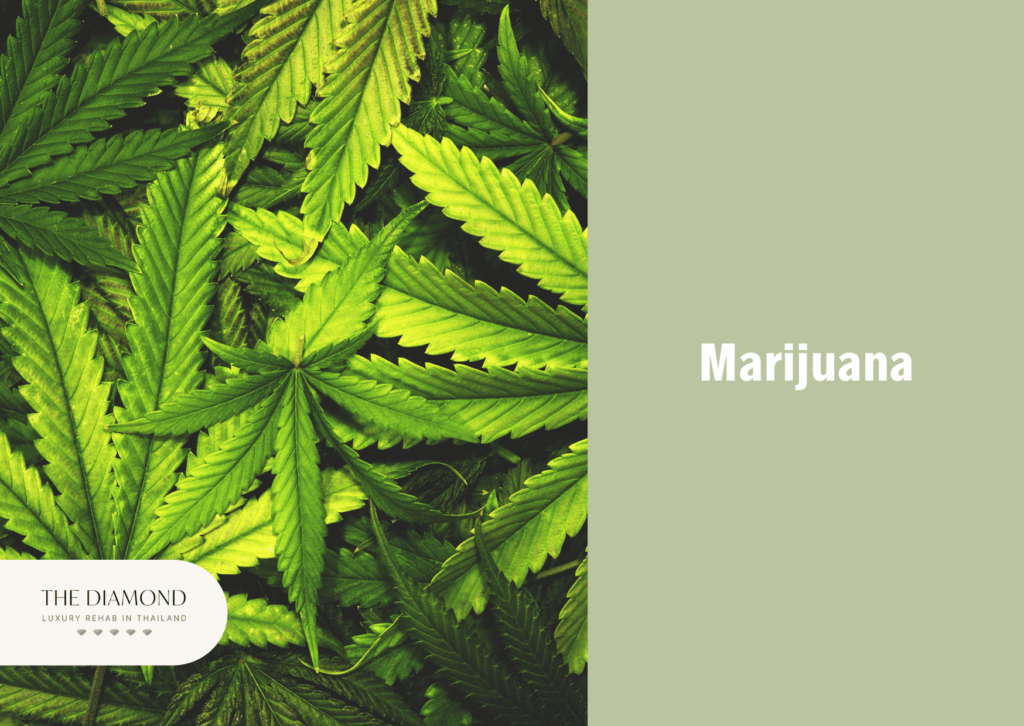
Marijuana addiction, or cannabis use disorder, is the inability to stop using marijuana despite the health or social problems it causes. Symptoms of marijuana addiction include continuing to use cannabis despite psychological or physical problems, craving marijuana, difficulty reducing or stopping cannabis use, giving up activities in favor of marijuana use, tolerance to cannabis, and withdrawal.
Affected people additionally experience taking more of the substance than intended and problems at work or school due to cannabis use.
There is no specific cause of marijuana addiction. Instead, addiction to cannabis results from emotional distress, stress, and other mental health conditions. The influence of the drug on the brain’s reward system is another important cause.
Risk factors for marijuana addiction include the parental history of a substance use disorder, peer substance use, cigarette smoking, novelty seeking, and past trauma.
Short-term effects of marijuana addiction include anxiety, money issues, and problems with time perception, memory, coordination, and pleasure. Long-term effects include cognitive impairment, respiratory issues, depression, anxiety, and worsening schizophrenia symptoms.
Psychotherapy is the main treatment route for men and women with marijuana addiction. It helps by teaching patients to identify destructive thought patterns, motivating them to change their behavior, and sticking to the treatment.
Managing withdrawal symptoms, which occur when a person stops taking the drug, is a valuable aspect of the treatment of this addiction. Common withdrawal symptoms are cravings, anger, nervousness, and reduced appetite.
One of the easiest ways to quit marijuana addiction is to find a healthy replacement for cannabis. This is something a doctor or therapist discusses during the appointment. Healthy lifestyle measures such as increased physical activity are valuable aspects of the treatment of this addiction.
The psychological effects of marijuana addiction refer to psychosis and long-lasting mental health disorders.
7. Amphetamines
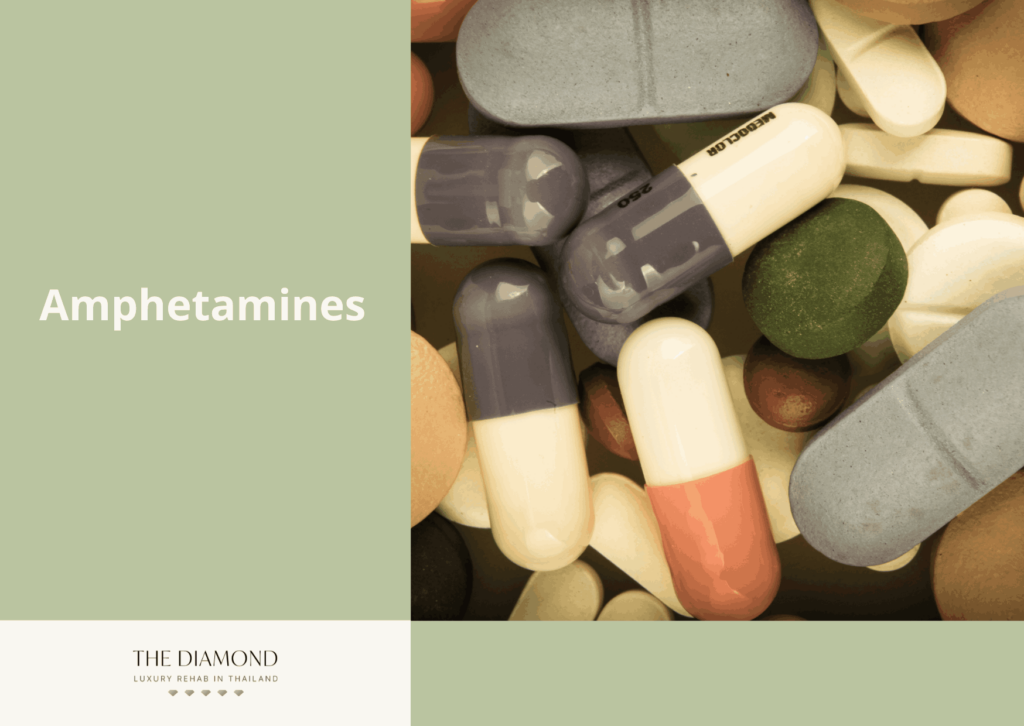
Amphetamine addiction is a type of physical addiction where a person keeps using these powerful stimulants even though they cause problems. The term amphetamine refers to drugs that stimulate the central nervous system. They are often prescribed for ADHD, narcolepsy, obesity, and depression.
Signs and symptoms of amphetamine addiction include frequent use of amphetamines in everyday life, feeling as if the body can’t function with these drugs, inability to stop despite attempts to do so, dedicating a lot of time and finances to obtain amphetamines, poor performance, and being secretive. People additionally experience an energy boost, paranoia, and psychosis.
Causes of amphetamine addiction result from environmental causes, genetics, and developmental problems.
Risk factors for amphetamine addiction include family history, underlying mental health disorder, peer pressure, lack of family involvement, and early first-time use.
Amphetamines, such as Adderall, cause feelings of energy or wakefulness, feelings of euphoria, and increased concentration and attentiveness. Besides these short-term effects, the long-term impact of amphetamine addiction includes damage to the brain and cardiovascular system, malnutrition, and erratic behavior.
Treatment for amphetamine addiction involves several approaches, such as medication-assisted treatment and therapy. The type of treatment depends on the severity of the addiction. Certain patients need inpatient treatment, whereas others benefit from the outpatient treatment program.
Medications are prescribed during the withdrawal process. Symptoms of amphetamine withdrawal include feelings of panic, anxiety, cravings, increased sleep duration, confusion, and paranoia.
In order to overcome amphetamine addiction, a person needs to fully engage in therapy sessions and participate in activities (or do homework) the therapist outlines. Introducing healthy lifestyle adjustments such as getting enough sleep or managing stress are useful aspects of overcoming amphetamine addiction.
The psychological impact of amphetamine addiction includes social and emotional problems, psychosis, paranoia, anxiety, and depression.
8. Hallucinogens
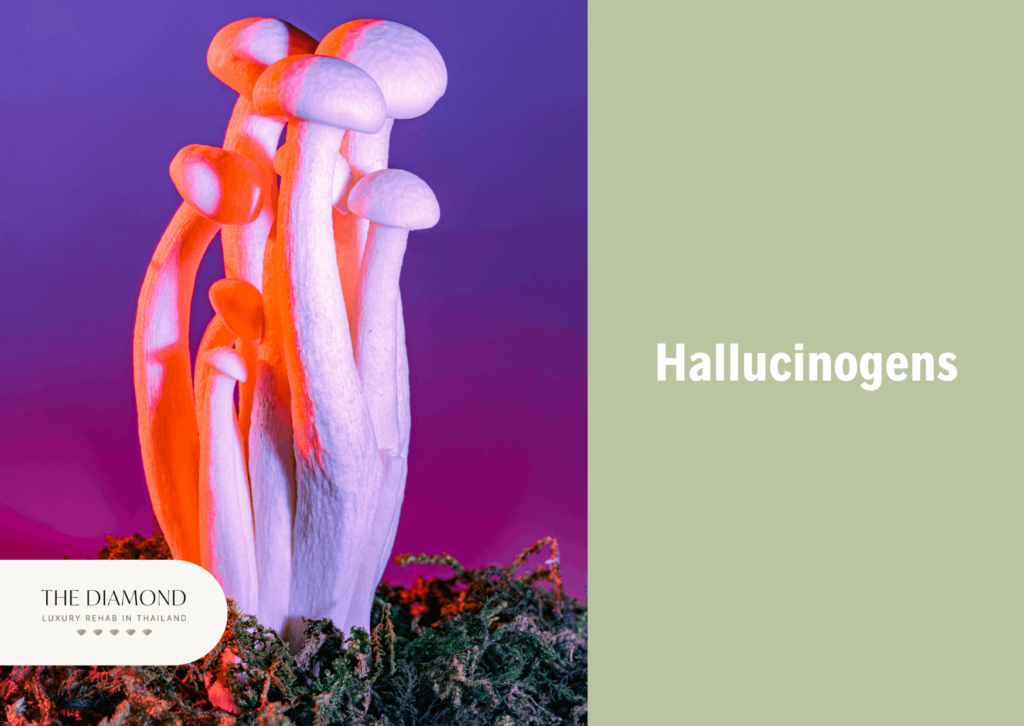
Hallucinogens addiction is the persistent urge to keep taking these drugs due to the sensory alterations they provide. The term hallucinogen refers to drugs that alter a person’s awareness of their surroundings, thoughts, and feelings. There are two types of hallucinogens. Classic hallucinogens include LSD whereas dissociative hallucinogens include drugs such as PCP.
This type of physical addiction is known as other hallucinogen use disorder. In this case, the word “other” serves to distinguish the hallucinogens causing the addiction from phencyclidine, which has its own disorder.
Symptoms of hallucinogen addiction include persistent and continuous use without harmful consequences, craving hallucinogens, impaired performance due to hallucinogens, reducing activities once found important, and spending a lot of time getting, using, and recovering from hallucinogens.
The causes of hallucinogen addiction aren’t exactly clear, but it is likely a combination of genes, mental health, and the environment.
Risk factors for this type of addiction include underlying psychiatric problems, childhood trauma, and substance abuse.
Short-term effects of hallucinogen addiction include dizziness, sleepiness, increased blood pressure, body temperature, and heart rate. Further short-term effects include impulsiveness, rapid emotional shifts, loss of appetite, sweating, dry mouth, numbness, and weakness.
On the other hand, the long-term effects of hallucinogen addiction are persistent psychosis and hallucinogen persisting perception disorder (HPPD). The latter refers to the recurrence of certain drug experiences through flashbacks without warning.
Treatment for hallucinogen addiction revolves around therapy. At this point, there is no specific medication approved by the United States Food & Drug Administration (FDA) to treat hallucinogen use disorder. A healthcare provider prescribes drugs to manage some underlying problems such as anxiety or depression.
What makes this type of physical addiction different is that it doesn’t produce specific withdrawal symptoms except for MDMA, which induces the same withdrawal symptoms as stimulants.
The best way to overcome hallucinogen addiction is to attend support group meetings regularly. In addition, it helps to remind oneself every day of all the reasons for quitting and the benefits of doing so.
The biggest psychological impact of hallucinogen addiction is the severity of anxiety and paranoia.
9. Inhalants
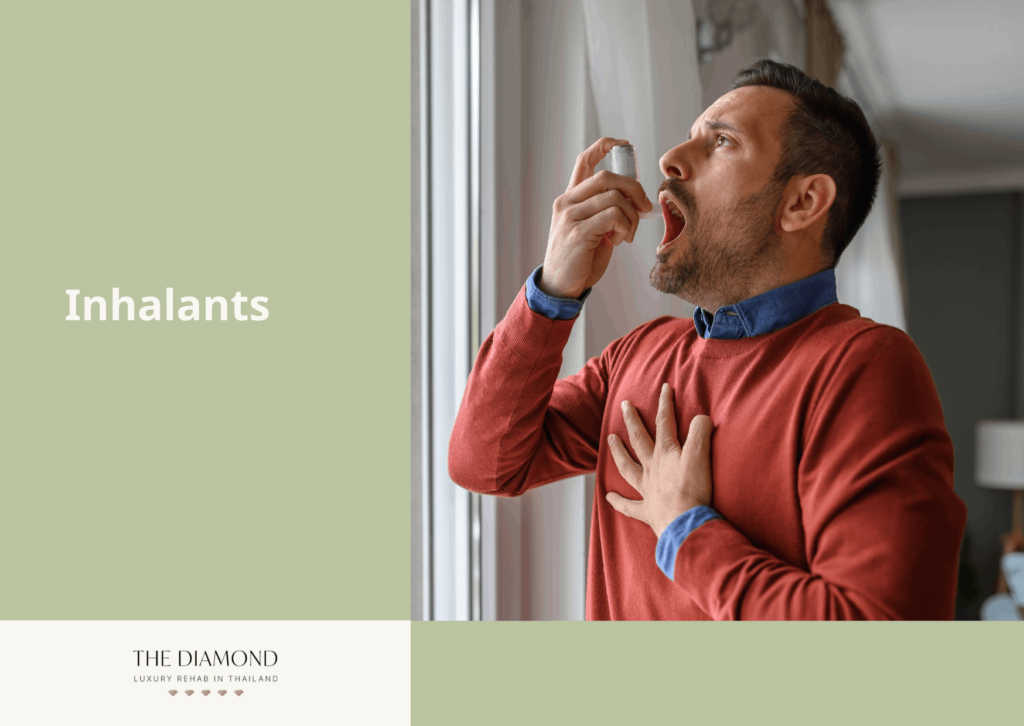
Inhalant use disorder is a type of physical addiction that develops when people deliberately inhale the fumes of various substances to experience intoxication. Inhalants are substances taken solely by inhaling and in no other way. Common inhalants are solvents, aerosol sprays, gases, and nitrites.
Symptoms of inhalant addiction range from chemical odor on breath or clothes and paint or other stains on hands or clothes to changes in behavior, lack of interest, reduced appetite, weight loss, sudden change in activities and hobbies, tiredness, slurred speech, decline in school or work performance, and ulcers or irritations around the nose and mouth.
The causes of inhalant addiction are family dysfunction, and easy access to inhalants since most people with this addiction are very young.
Risk factors for inhalant addiction include family history, dysfunctional family relationships, personal history of mental health problems, a greater degree of behavioral disinhibition, involvement with people who abuse inhalants, and homelessness.
Short-term effects of inhalant addiction include belligerence, impaired judgment, apathy, and impaired functioning. On the other hand, long-term effects cause various problems including delirium and confusion as well as muscle weakness, overdose, instability, lack of coordination, and depression. This addiction causes liver and kidney damage, bone marrow damage, hearing loss, and brain damage.
Treatment for inhalant addiction includes cognitive-behavioral therapy, motivational interventions, family counseling, activity and engagement programs, and support groups. The main goal of these treatment approaches is to help patients understand their problem and change it through skills that people learn through therapy sessions.
Teaching patients life skills training helps them overcome inhalants addiction. The best thing for a person to do in the process of recovery is to stick to therapy sessions. This is known as the most important approach for the management of withdrawal symptoms.
Not everyone experiences withdrawal symptoms, but those that do tend to report severe headaches, runny nose, nausea and/or vomiting, sleep disturbances, severe hallucinations, delusions, restlessness, and anxiety.
The most significant psychological impacts of inhalant addiction are irritability, hostility, and paranoia. For that reason, a person needs to work on their recovery closely with a therapist.
10. PCP
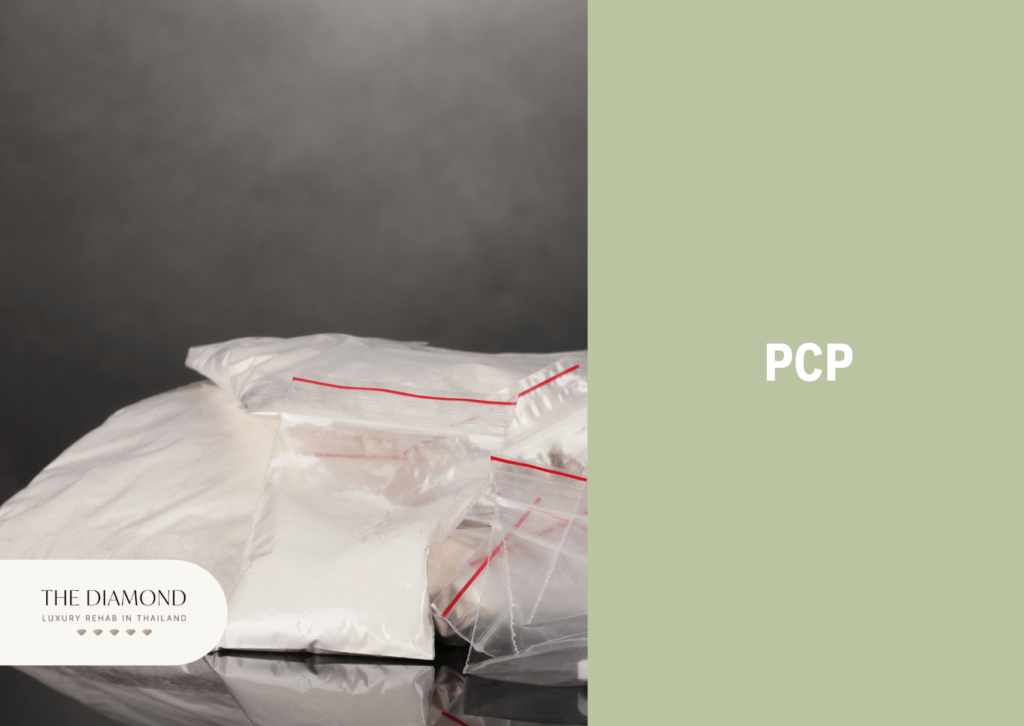
PCP addiction is a physical addiction to the powerful hallucinogen phencyclidine, otherwise known as angel dust. Originally developed as an anesthetic, PCP is known for inducing hallucinations and feelings of detachment.
Symptoms of PCP addiction include the need to use the drug daily, gradually increasing amounts of PCP used, spending money on the drug, impairments in daily life, inability to stop using the drug, engaging in risky activities under the influence of the drug, and doing things an individual normally doesn’t engage in.
While the cause of PCP addiction is unclear, it is potentially due to the impact of the substance on glutamate, dopamine, and serotonin levels of the brain. Risk factors of PCP addiction include a personal history of substance use, family history of substance use, exposure to violence and trauma, being surrounded by PCP users, and exposure to crime.
Short-term effects of PCP addiction include slurred speech, motor coordination, bloodshot eyes, and euphoria. People with PCP addiction additionally experience symptoms such as hallucinations, dissociative effects, and aggressiveness.
Long-term effects of PCP addiction include brain damage, psychotic issues, HPPD, and memory loss.
Treatment for PCP addiction is done through inpatient, outpatient, and support groups. Patients who are experiencing withdrawal symptoms usually undergo detox under medical supervision first. When it comes to withdrawal, symptoms occur within eight hours after the last use, but they last several months to a year.
An inpatient program is suitable for patients with severe PCP addiction. A patient is required to spend up to 30, 60, or 90 days in the treatment facility. The outpatient program is more suitable for persons with mild to moderate addiction.
In order to overcome PCP addiction, a patient needs to understand their triggers first. Then they need to avoid those places, people, or situations, or they reduce exposure to them.Proper treatment is particularly necessary if we bear in mind that PCP is unpredictable and makes a person severely disconnected from reality. Besides these psychological effects, PCP additionally causes extreme paranoia.
What are the treatments available for physical addiction?
Available treatments for physical addiction depend on the type of addiction or substances abused. Standard treatments for physical addiction are listed below.
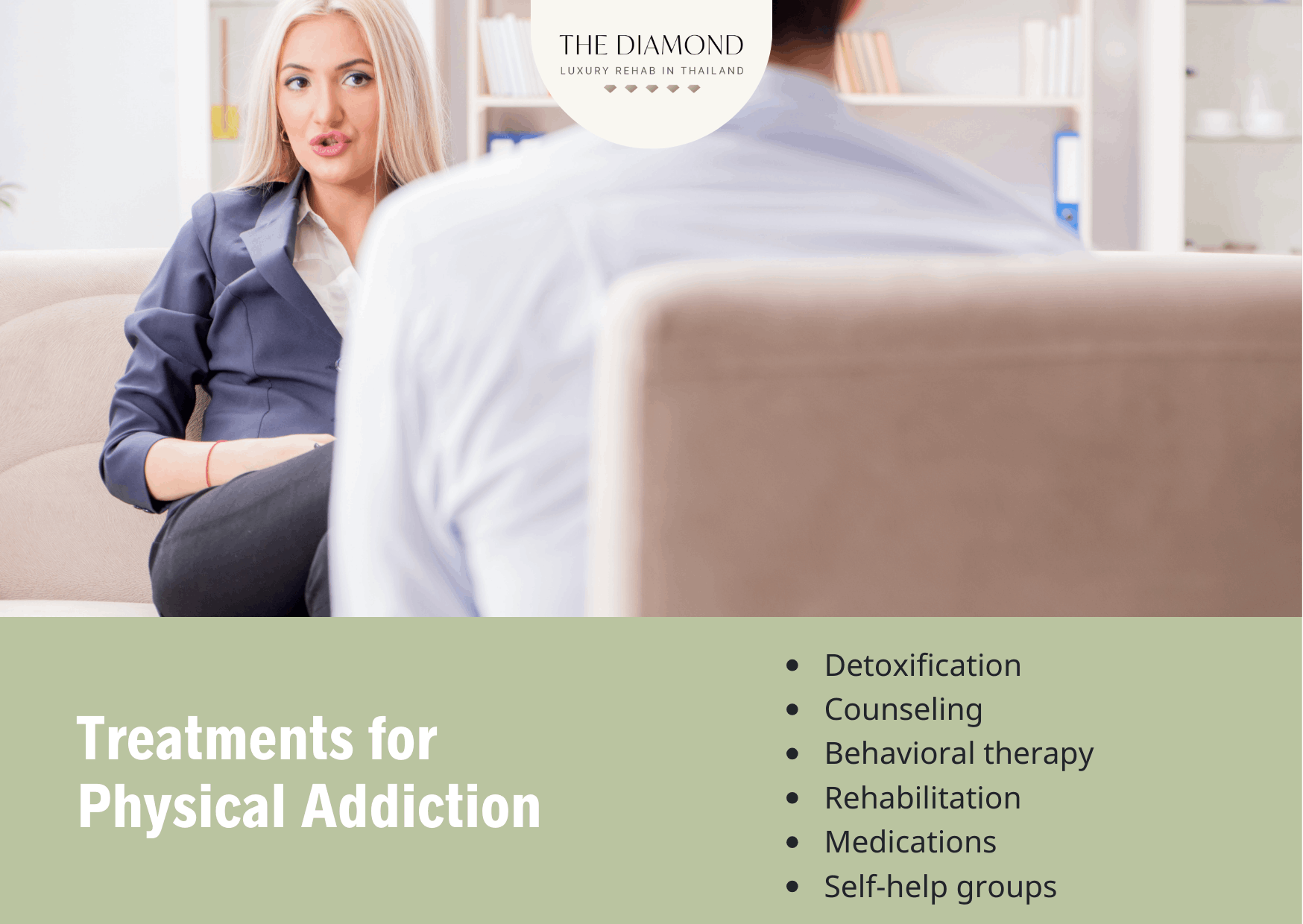
- Detoxification
- Counseling
- Behavioral therapy
- Rehabilitation
- Medications
- Self-help groups
1. Detoxification
Detoxification (detox) is the first stage of the recovery process i.e. the period when a person stops taking the addictive substance. In other words, detox is the elimination of an addictive substance from the body after the body has adjusted itself to having the specific substance regularly. The main purpose of detox is to safely manage withdrawal symptoms. For that reason, detox is performed in a clinical setting.
Withdrawal symptoms occur within a few hours after the last use of an addictive substance, peak in two to three days, and last seven days. Other people experience withdrawal symptoms for two to three weeks.
Detox helps because it eliminates the addictive substance from the body and restores pre-addiction functioning as much as it can. Since various types of addiction induce severe withdrawal symptoms, this process is performed under medical supervision.During detox, one must expect to receive medications that reduce cravings for the drug. Patients additionally need to expect various physical and psychological symptoms. These include nausea/vomiting, irritability, shaking, sweating, exhaustion, headaches, seizures, hallucinations, and delirium.
2. Counseling
Counseling is talk therapy, wherein a trained therapist listens to a patient and helps them find ways to deal with their emotional issues. In addiction treatment, counseling works by enabling patients to cope with life and stay clean. The counselor helps patients identify goals and potential solutions to their problems.
Counseling helps because it improves the quality of life among patients. They get to learn coping skills, improve self-esteem, and become motivated to work on changing their behaviors.
Patients must expect counseling to dig deeper in order to get answers regarding their behaviors and their causes. Counselors typically ask a lot of questions or give a questionnaire to complete. It is necessary to be proactive and participate.
Counseling lasts 45 to 60 minutes. In the treatment of addiction, counseling is necessary for three months or longer.
3. Behavioral therapy
Behavioral therapy is a term that describes various techniques used to change maladaptive behaviors. The main goal of behavioral therapy is to reinforce desirable behaviors and eliminate unwanted ones. The most significant form of therapy for patients with addiction combines both behavioral and cognitive aspects. It is called cognitive-behavioral therapy (CBT).
Behavioral therapy works by using reinforcement, shaping, modeling, and other similar techniques to alter behavior. In cases of CBT, the therapy works by enabling a patient to identify negative or disruptive thoughts that lead to and worsen addiction.
This therapy helps because patients get to work on the main causes of addiction. They feel more empowered to tackle addiction and develop or adopt various skills to support their recovery.
Patients need to expect that therapy sessions often last 45 to 60 minutes. Included in these expectations are well-structured sessions and homework. The goal of homework is to practice the skills mentioned during the session.
The length of therapy varies from one patient to another, but for most people, it’s three months minimum.
4. Rehabilitation
Rehabilitation is one of the most important aspects of addiction treatment. It is the process of addiction treatment in a structured and time-limited manner. Patients undergo inpatient or outpatient programs.
An inpatient program is reserved for more serious cases, whereas the latter is required for mild to moderate cases of addiction. The outpatient program additionally helps persons who have completed inpatient treatment but need more support.
This begs the question, “What is rehabilitation?” and how does it really work? Rehabilitation works through a structured plan and regular therapy sessions, during which patients learn and adopt much-needed skills to overcome obstacles in life without using drugs or other addictive substances.
It helps because patients get support and motivation to stick to their recovery and work on getting better. The main goal is to return people to productive functioning in society.
During rehabilitation, patients are going to benefit the most from attending therapy sessions regularly, where they’re able to work with different healthcare professionals in the entirety of the process.
The length of the rehabilitation process varies, but it’s usually 30, 60, or 90 days.
5. Medications
The use of medications in addiction recovery is called medication-assisted treatment (MAT). It works by using medicines to reduce cravings and decrease the intensity of withdrawal symptoms. MAT is never an individual treatment approach and is always used in combination with behavioral therapy.
It helps by improving patient survival, increasing patient retention in the treatment, reducing drug use, increasing patients’ ability to gain and maintain employment, and improving birth outcomes among women with physical addictions. In this approach, patients receive medications such as methadone, naltrexone, buprenorphine, or naloxone, depending on the type of their addiction. This treatment is short-term, usually up to 12 months.
6. Self-Help Groups
Self-help groups are support groups where people with the same problem meet and share their experiences. They work by allowing people to get and receive support during their recovery process.
Self-help groups help because they show patients with physical addictions they are not alone. Other people face the same problems, and their experiences help them during addiction treatment. Self-help groups are all about understanding others and being understood.
That’s why patients must expect to be asked to share about their journey to recovery. Full participation is required and expected. Ideally, attending self-help groups needs to be a long-term commitment because they are excellent for maintaining recovery and reducing the risk of relapse.
Is it possible to treat physical addictions?
Yes, it is possible to treat physical addictions. With the right treatment plan and resources, achieving recovery is possible. Quitting physical addiction is a complicated process, which is why professional help is the best option.
Long-term follow-up studies on patients in treatment reveal that the majority of those who enter and stay in treatment quit using drugs, cut down on their criminal activities, and enhance their social, psychological, and professional functioning, as per the National Institute on Drug Abuse’s 2014 publication titled, “Principles of Drug Addiction Treatment: A Research-Based Guide (Third Edition)”.
When it comes to treatment for physical addictions and its effectiveness, it’s important to bear in mind that the chronic aspect of addiction means the relapse isn’t just possible but likely. That said, relapse doesn’t automatically indicate failure of addiction treatment. Successful treatment for addiction calls for continual evaluation and modification. The approach is similar to the treatment of other chronic conditions.One of the most significant principles of addiction treatment is understanding that addiction is a complex but treatable disease. The second principle is acknowledging that no single treatment works for everyone equally, and treatment must be readily available. Remaining in treatment for an adequate time period is crucial. Treatment of physical addictions requires a strong support system as well.

